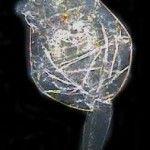acute Rotoxkit M
The cyst-based marine rotifer toxicity test is intended for toxicity screening of chemicals, contaminated coastal and estuarine waters, effluents or elutriates with high conductivity values, biotoxins and marine sediment pore waters.
In Rotoxkit M, you find all the materials you need to perform six acute 24-48h mortality tests with the marine rotifer Brachionus plicatilis. This bioassay conforms to ISO Standard 19820 and is cost-effective, culture-independent, and user-friendly.
Test criterion
The acute marine rotifer toxicity test is a 24-48h bioassay based on the mortality of the test organisms, with calculation of the 24h and 48h LC50. Learn more about the rotifer toxicity test procedure
Contents of the Rotoxkit M
The ROTOXKIT M contains all the materials necessary to perform six acute toxicity tests with the marine rotifer* Brachionus plicatilis.
Rotifers are ecologically important members of freshwater and marine aquatic communities and have very rapid turnover rates.
Easy to follow instructions and detailed illustrations are provided in the toxicity kits for the conduct of range-finding and definitive tests. The test organisms are included in the kits as dormant eggs (cysts) which can easily be hatched on demand, in less than 24h, to supply the live biota for the conduct of the assays.
- Tubes with cysts (dormant eggs), which you can hatch on demand within 26h to supply the live biota for the Brachionus plicatilis toxicity test.
- Concentrated hatching and toxicant dilution medium, hatching and test containers and micropipettes for the transfer of the organisms.
- Short Bench Protocol and standard operating procedure brochure with easy-to-follow instructions and detailed illustrations.
- Data scoring sheets and a Quality Control specification sheet with batch number of the cysts and the media.
All test materials and equipment included in the Rotoxkit M are available separately.
Reproducibility
- We produce high-quality cysts in strictly controlled conditions. This way, we preclude variability associated with recruitment/maintenance of live stocks in conventional bioassays.
- The quality of the standardised test medium is highly uniform, thanks to simple dilution of concentrated solutions of selected salts with deionised water.
- A Quality Control test with a reference chemical is described in detail, so you can easily check accuracy and reproducibility.
Cost-Effectiveness
- You can hatch the cysts on demand, which eliminates the need and the costs of continuous culturing and maintenance of your test organisms.
- The marine rotifer toxicity test requires minimal space and equipment:
-
- dissection microscope
- incubator with lateral lights
- conventional laboratory glassware
- If you store the cysts properly, you can prolong their shelf life for several months and reduce test scheduling constraints.
Contents
Tubes with cysts, concentrated hatching and toxicant dilution medium, hatching/test containers and micropipettes for the transfer of the organisms.
Detailed Standard Operational Procedure brochure, abbreviated Bench Protocol, data scoring sheets and graphical LC50 calculation sheets.
Specification sheet with batch number of the cysts and the media.
User-Friendliness
- Simple handlings and scorings.
- Specially designed test wells for easy and rapid transfer of the test organisms under a dissecting microscope.
- Total performance time of the Brachionus plicatilis toxicity assay is approximately 1 hour.
- We can provide you with a computer program for easy Toxkit data treatment.
Sensitivity
- Brachionus plicatilis is quite sensitive to particular chemicals and mixtures.
- Sensitivity can be increased substantially by extending the exposure time from 24h to 48h.
Applicability
Marine rotifer Brachionus plicatilis is a euryhaline organism, which allows you to perform bioassays on waters in a salinity ranging from 5-10 ppt (brackish water) to 35ppt (seawater).
Validation
- The marine Rotoxkit M is used in many environmental laboratories and research institutes worldwide for standardised screening of environmental samples.
- You can find a substantial number of publications, posters, reports and reviews for various uses.
- Our marine rotifer toxicity test strictly adheres to the principles of ISO Standard 19820 for regulatory testing with rotifers.







